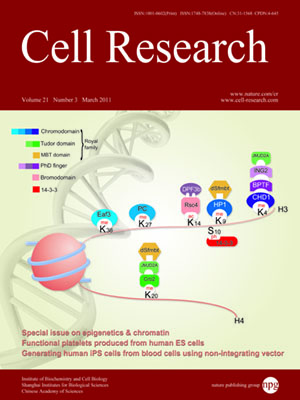
Volume 21, No 3, Mar 2011
ISSN: 1001-0602
EISSN: 1748-7838 2018
impact factor 17.848*
(Clarivate Analytics, 2019)
Volume 21 Issue 3, March 2011: 486-501
REVIEWS
Reprogramming to pluripotency: stepwise resetting of the epigenetic landscape
Bernadett Papp and Kathrin Plath
David Geffen School of Medicine, Department of Biological Chemistry, Jonsson Comprehensive Cancer Center, Molecular Biology Institute, Eli and Edythe Broad Center of Regenerative Medicine and Stem Cell Research, University of California Los Angeles, 615 Charles E. Young Drive South, Los Angeles, CA, 90024, USA
Correspondence: Kathrin Plath,(kplath@mednet.ucla.edu)
In 2006, the “wall came down” that limited the experimental conversion of differentiated cells into the pluripotent state. In a landmark report, Shinya Yamanaka's group described that a handful of transcription factors (Oct4, Sox2, Klf4 and c-Myc) can convert a differentiated cell back to pluripotency over the course of a few weeks, thus reprograming them into induced pluripotent stem (iPS) cells. The birth of iPS cells started off a rush among researchers to increase the efficiency of the reprogramming process, to reveal the underlying mechanistic events, and allowed the generation of patient- and disease-specific human iPS cells, which have the potential to be converted into relevant specialized cell types for replacement therapies and disease modeling. This review addresses the steps involved in resetting the epigenetic landscape during reprogramming. Apparently, defined events occur during the course of the reprogramming process. Immediately, upon expression of the reprogramming factors, some cells start to divide faster and quickly begin to lose their differentiated cell characteristics with robust downregulation of somatic genes. Only a subset of cells continue to upregulate the embryonic expression program, and finally, pluripotency genes are upregulated establishing an embryonic stem cell-like transcriptome and epigenome with pluripotent capabilities. Understanding reprogramming to pluripotency will inform mechanistic studies of lineage switching, in which differentiated cells from one lineage can be directly reprogrammed into another without going through a pluripotent intermediate.
Cell Research (2011) 21:486-501. doi:10.1038/cr.2011.28; published online 15 February 2011
FULL TEXT | PDF
Browse 2025


